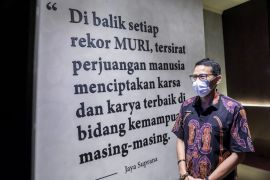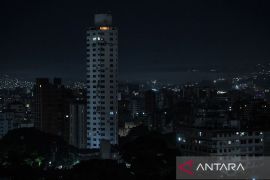This kites museum also stores kites from abroad, such as Turkey, the Netherlands, South Korea, the Philippines, Cambodia, India, Japan, China, Thailand, Malaysia, Sri Lanka, Sweden, and FranceJakarta (ANTARA) - Several tourist destinations offer myriad options for families and school students to spend their school holidays in the even semester of the 2021-2022 academic year.
Apart from shopping centers, which are very common, museums can also be a choice.
Jakarta is the city, with the most number of museums in Indonesia, reaching over 70, which can be visited by the public, according to the Statistics Indonesia (BPS) official website.
By visiting museums, school students not only gain a plethora of benefits, such as learning agility and creativity, but they can also obtain extensive knowledge of history that can later be useful while entering the new academic year.
One of the many museums in Jakarta is the Museum Layang-Layang, or the Kites Museum of Indonesia, located on H Kamang Street, Pondok Labu, South Jakarta. This museum offers several activities, such as painting and making kites, painting umbrellas, and watching the history of kites.
"I took the children to the Kites Museum because I wanted to provide (them) a useful vacation. Hence, when they enter school, they can tell about their experiences," Winda Surci, a Solo resident, who visited the museum on Thursday (June 30), stated.
Related news: Turning off lights simple, impactful for sustainability of earth
The Museum of Kites showcases several types of kites originating from Indonesia and also overseas.
By paying an entrance ticket of Rp20 thousand for children and Rp25 thousand for adult visitors, the museum will invite them to try out new things that are not commonly done at home or at school.
"By paying for tickets, visitors will be able to enjoy three activities: firstly, it is watching a historical film about kites; then there is a museum tour to get to know more about kites, and finally, they will be taught to make kites from paper," the tour guide of the Kites Museum, Asep Irawan, explained.
The paper kites can also be decorated and taken home.
Related news: MRT Jakarta, private sector cooperate on integrating transportation
Inside the museum
The museum building, built with Balinese and Javanese architectural styles, stands on an area of 2,750 sq. m. and is filled with several lush trees.
The relaxing atmosphere makes visitors feel that they are not in the south of the capital city, which is usually bustling.
The museum, which was inaugurated by the former minister of culture and tourism, I Gede Ardhika, on March 21, 2003, made it the first kite museum in Indonesia.
"The presence of the kite museum is to preserve the characteristics of Indonesian culture through kite art," Irawan noted.
Before it was established as a museum, the owner, Endang W. Puspoyo, initially focused on the beauty industry sector.
At first, Puspoyo opened a kite gallery, and she was quite fond and happy with the world of kites.
In the 1990s, Puspoyo often invited kite artists from various regions to participate in festivals to enliven the art of kites in Indonesia.
It was from these artists that Puspoyo obtained several kites, as those coming to the festival donated a lot of their works to be displayed in the museum and some even sold their artworks after the festival ended.
"In the festival, not all the kites were taken home, as some were sold for (the artists') return fare, and some were donated to be displayed in the gallery," Irawan remarked.
"As the number of kites (donated to the museum) increased, Puspoyo then had the idea to open this museum," he added.
Related news: Anies receives Lord Mayor of London to explore green investment
Variety of kites
The Kites Museum of Indonesia not only stores artworks from artists throughout regions of Indonesia, but there are several kites coming from world artists in this pendhapa-shaped building.
This pendhapa, or pavilion, keeps unique kites from the smallest size measuring two centimeters to the largest reaching 5x3 meters (m).
"This museum also has a kite that has a length of 100 m, but it does not fit on display," Irawan said.
Irawan, who also works as a kite artist, explained that this museum has a large collection of kites as souvenirs while visiting kite festivals abroad.
"Usually, if we go there or they come here, some are donated to the museum as well," he said.
The wooden-floor museum building has at least 20 collections of kites from foreign countries on display.
Related news: Term ends soon, but performance will not slacken: Jakarta Governor
Irawan said, the showcasing aims to emphasize that kites are not only popular in Indonesia but also in the global community.
"This kites museum also stores kites from abroad, such as Turkey, the Netherlands, South Korea, the Philippines, Cambodia, India, Japan, China, Thailand, Malaysia, Sri Lanka, Sweden, and France," he pointed out.
Furthermore, the museum has a replica of the first kite in Indonesia. In the past, Irawan explained, kites were made of natural materials, such as kolope (tuber) leaves. The shape of the kite was diamond and came from the Muna Island area, Southeast Sulawesi.
The making of the kites took three to seven days, and they are used by ancient humans to seek God.
"The first history (of kites is) in Indonesia. There is even research that (states) this kite is the first in the world. There is only the replica here. Historically, ancient humans flew the kite to seek God, but they failed to find (God)," he stated.
Related news: A bid to draw more Japanese investment into Indonesia
Related news: Jokowi meets UAE President at Al Shatie Palace
Editor: Fardah Assegaf
Copyright © ANTARA 2022











